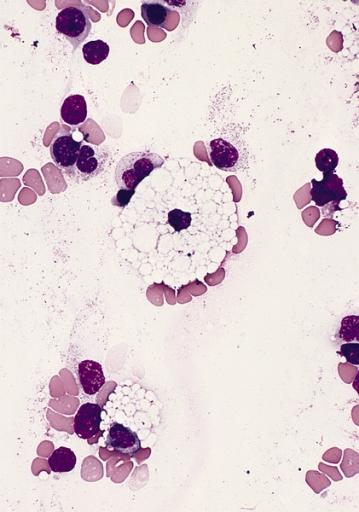Niemann-Pick disease: Difference between revisions
m (Robot: Automated text replacement (-{{SIB}} +, -{{EH}} +, -{{EJ}} +, -{{Editor Help}} +, -{{Editor Join}} +)) |
m (Robot: Automated text replacement (-{{WikiDoc Cardiology Network Infobox}} +, -<references /> +{{reflist|2}}, -{{reflist}} +{{reflist|2}})) |
||
| Line 58: | Line 58: | ||
==References== | ==References== | ||
{{reflist}} | {{reflist|2}} | ||
{{Metabolic pathology}} | {{Metabolic pathology}} | ||
Revision as of 20:07, 4 September 2012
For patient information click here
| Niemann-Pick disease | |
 | |
|---|---|
| Bone marrow aspirate smear from a child with Niemann-Pick disease. A large foamy histiocyte typical of this disorder is illustrated. (Wright-Giemsa stain). Image courtesy of Professor Peter Anderson DVM PhD and published with permission © PEIR, University of Alabama at Birmingham, Department of Pathology | |
| ICD-10 | E75.2 (ILDS E75.230) |
| ICD-9 | 272.7 |
| MeSH | D009542 |
Template:Search infobox Editor-In-Chief: C. Michael Gibson, M.S., M.D. [1]
Overview
Niemann-Pick disease is an autosomal recessive disorder affecting lipid metabolism (the breakdown and use of fats and cholesterol in the body), in a way which causes harmful amounts of lipids to accumulate in the spleen, liver, lungs, bone marrow, and brain.
There are three variants of Niemann-Pick disease based on the genetic cause and the symptoms exhibited by the patient.
Genetics
Mutations in the NPC1, NPC2, and SMPD1 genes cause Niemann-Pick disease.
This condition is inherited in an autosomal recessive pattern, which means two copies of the gene must be altered for a person to be affected by the disorder. Most often, the parents of a child with an autosomal recessive disorder are not affected but are carriers of one copy of the altered gene. If both parents are carriers, there is a 25% chance with each pregnancy for an affected child. Genetic counseling and genetic testing is recommended for families who may be carriers of Niemann-Pick.
Types
Types A and B
Type A Niemann-Pick disease begins during infancy and is characterized by an enlarged liver and spleen (hepatosplenomegaly), failure to thrive, and progressive deterioration of the nervous system. Children affected by this condition generally do not survive past early childhood. Niemann-Pick disease, type A occurs more frequently among individuals of Ashkenazi (eastern and central European) Jewish descent than in the general population. The incidence within the Ashkenazi population is approximately 1 in 40,000 people. The incidence for other populations is unknown.
Type B disease may include signs of hepatosplenomegaly, growth retardation, and problems with lung function including frequent lung infections. Other signs include blood abnormalities such as abnormal cholesterol and lipid levels, and low numbers of blood cells involved in clotting (platelets). People affected by this type of Niemann-Pick disease usually survive into adulthood. Niemann-Pick disease, type B occurs in all populations.
Mutations in the SMPD1 gene cause Niemann-Pick disease, types A and B. This gene carries instructions for cells to produce an enzyme called acid sphingomyelinase. This enzyme is found in the lysosomes (compartments that digest and recycle materials in the cell), where it processes lipids such as sphingomyelin. Mutations in this gene lead to a deficiency of acid sphingomyelinase and the accumulation of sphingomyelin, cholesterol, and other kinds of lipids within the cells and tissues of affected individuals.
Type C
Type C is characterized by onset in childhood, although infant and adult onsets are possible. Other signs include severe liver disease, breathing difficulties, developmental delay, seizures, increased muscle tone (dystonia), lack of coordination, problems with feeding, and an inability to move the eyes vertically. People with this disorder can survive into adulthood. The incidence of Niemann-Pick disease, type C is estimated to be 1 in 150,000 people. The disease occurs more frequently in people of French-Acadian descent in Nova Scotia.
Mutations in either the NPC1 or NPC2 gene cause Niemann-Pick disease, type C. The NPC1 gene produces a protein that is located in membranes inside the cell and is involved in the movement of cholesterol and lipids within cells. A deficiency of this protein leads to the abnormal build up of lipids and cholesterol within cell membranes. The NPC2 gene produces a protein that binds and transports cholesterol, although its exact function is not fully understood.
Biochemical Transport
The molecular basis for this disease is extremely complex due to the role that endosome formation has on affected patients. Recently, three theories have attempted to explain the buildup of cholesterol in the lysosomes of affected patients of Niemann-Pick Disease Type C due to the malfunction of the protein NPC-1.
- The contention by Neufel et al is that the buildup of mannose 6-phosphate receptors (MPRs) in the late endosome suggests that the retrograde breakdown of cholesterol via the Trans Golgi Network cannot occur.[1]
- Another theory suggests that the blockage of retrograde cholesterol breakdown in the late endosome is due to decreased membrane elasticity and thus the return vesicles of cholesterol to the Trans Golgi Network cannot bud and form.
The support of these theories has considerable evidence using mutant proteins in vitro to determine the buildup of cholesterol in the lysosomes. Researchers have also discovered that the NPC-1 protein may function as a pump of cholesterol.[2]
The overall effect of a malfunction in NPC-1 is that low levels or an absence of the protein lead to the abnormal accumulation of lipids and cholesterol in the cells of people with this condition.
External links
The U.S. National Library of Medicine
References
- ↑ Neufeld EB, Wastney M, Patel S; et al. (1999). "The Niemann-Pick C1 protein resides in a vesicular compartment linked to retrograde transport of multiple lysosomal cargo". J. Biol. Chem. 274 (14): 9627–9635. PMID 10092649.
- ↑ Davies JP, Chen FW, Ioannou YA (2000). "Transmembrane molecular pump activity of Niemann-Pick C1 protein". Science. 290 (5500): 2295–2298. doi:10.1126/science.290.5500.2295. PMID 11125140.
de:Niemann-Pick-Krankheit it:Malattia di Niemann-Pick fi:Niemann–Pickin tauti